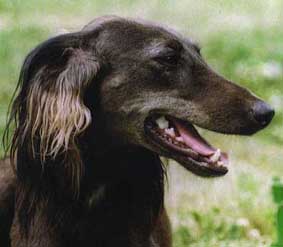
Reflections on Sir
Terence Clark's article
“The northern frontiers of Salukidom”.

By Sergiy Kopylets'
The very
interesting material that Sir Terence Clark
kindly offered us for publication in our magazine
has encouraged me to reflect on the origin and
distribution of Asiatic Sighthounds.
I consider therefore that I should share these
reflections with our readers.
The facts adduced in the article “The northern
frontiers of Salukidom” once again confirm the
view, which I expressed in “The Crimka”, that all our
“Salukis”, “Sloughis”, “Tazys”,
“Taigans” and “Aboriginal Afghans” represent in essence
one breed with rich, local derivatives
or indeed very similar breeds, which come from one source and it
is difficult to draw a firm
boundary between them, particularly in areas where different
breeds live side by side and form
numerous transitional types.
Moreover the breeds united by rather artificial standards, which
have been established by
cynologists who are sometimes unfamiliar with local
circumstances, often break down
individually into clearly defined types, which may differ one
from another so that it is
difficult to compare the representatives of the different types,
though officially of one
breed, in the show ring.

Photo
of a bitch of the South Kazakhstan type
Photo by L. Kost'unina (S-Peterburg)
The
stock of Tazys that has been preserved in Kazakhstan until
today may be broken down as a minimum into two clear breed
types. The Southern (“Chimkent”): with a somewhat elongated
form of the body, a rather broad rib cage, prominent musculature,
a somewhat underdeveloped coat (completely smooth-coated
individuals occur) and medium height (60-67 cm at the shoulder).
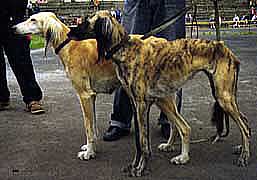
Photo
of a Tazy of the “Semirichinsky” type
Photo by V. Jevdokimov (Kovel', Ukraine)
The South-eastern (“Semirichinsky” comes from the
Kazakh “Jetisu”, which indicates the Semirichye region
that covers the territory in the south-east of Kazakhstan
and the adjacent parts of Kyrgyzstan): with a shorter,
often square shape, a comparatively narrow chest, a flat, dry
sort of musculature, well
developed ear fringes, thigh and tail feathering and taller build
(bitches often more than 65 cm
and dogs 70 cm at the shoulder).
The best typical colour for the Southern breed is black and
white, while the Semirichinsky
is all shades from dark brown to red. There is a series of other
differences that distinguishes
the two types from one another.
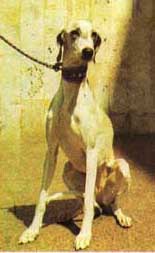
Photo
of a bitch of the Turkmen type
from the magazine “Cynodrome” No. 1/1994
The
Turkmen Tazys (or Tazis) are so distinctive that they may merit
designation as a separate breed. Apart from its small build
(55-60 cm
at the shoulder), the “Turkmenki” are significantly leaner
and more
delicate than their relatives from the other breeds and also have
a somewhat different shape of head with a rounder cranium,
prominent eyes and a pointed snout.
M. Bogdanov and L. Sabaneyev noticed the high exterior breeding
of the Turkmenki in the 19th century. Unfortunately for the past
50
years the Turkmen Tazys, as well as the other breeds of Central
Asian
Sighthounds on the territory of the former Soviet Union, have
significantly degenerated as
a result of crossbreeding and the loss of an important part of
the breeding stock.
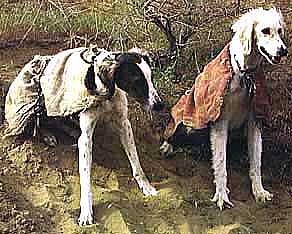
Photo
of contemporary Turkmen Tazys
by Henry Loewenstein
Untypical
colours, coat length and
coarse physiques have appeared.
Photo of a group of
Taigans at the 105th Moscow Show
from the magazine “Hunting” Number 7-8/1998
Over a
significant part of the area of their distribution Tazys border
on Taigans, where
in a broad belt of adjacent regions of Kazakhstan and Kyrgyzstan
there is an intermediate
type of these Sighthounds. They have a breed name only thanks to
the native tradition
of the Kazakhs and the Kyrgyz, because in fact they are
practically indistinguishable.
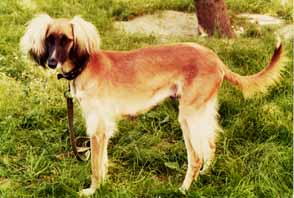
Photo of Nancy – a Kyrgyz bitch – Tazy or Taigan
– by Igor Yaroshenko, Kiev
Thus the Sighthounds of Kyrgyzstan often do not
have the necessary, characteristic for Taigans and
Afghan Hounds, undercoat (“taiganina”).
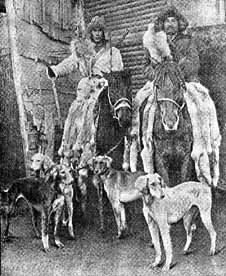
Photo of Kyrgyz hunters
with Taigans from the book by E. I. Shereshevsky
“Borzois and hunting with them”, Moscow 1953.)
Photo
of Kazakhs with Tazys from the magazine
“Hunting and Hunting Economy”, Number 5, 1960
Already
at the end of the '80s the cynologist and author on Taigans from
the south
of Kazakhstan V. Vyrypaev proposed in the magazine “Hunting and
Hunting Economy”
the division of this breed into two types: the coarse, rather
short-legged and heavily feathered
type of Sighthound and the type of Sighthound of the more level
foothills with a more elegant
physique, long legs and little hair.
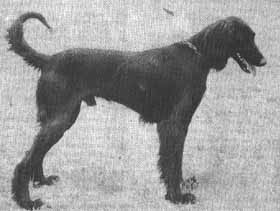
Photo
of a Taigan of V. Vyrypaev
from the Djambul region of southern
Kazakhstan by G.Sakalaos
In
essence this plains Taigan is indeed
that intermediate breed type between
the Kazakh Tazys and the Taigans.
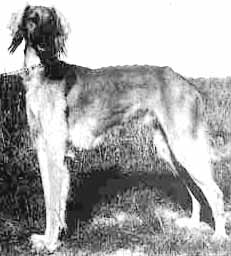
Photo
of the Semirichensky type of Tazy
from the magazine “Cynodrome” No. 1/1994
From
personal experience I know that the Kazakh Tazys,
especially the young ones, have feathering like Taigans.
How can I not mention here the “Afghan” Chipak
from Sir Terence Clark's article?
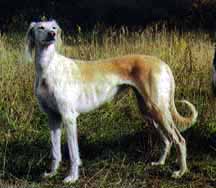
Photo
of a Tazy of the southern Kazakh type
by Svetlana Chernyaeva
It seems
to me that the Tazys of the southern Kazakh
type also have a definite genetic closeness to the Taigans,
which explains their exterior characteristics and the typically
Taigan colour.
It is accepted to consider the Taigans as a particularly
Kyrgyz national breed but as is known the race of high-mountain
Sighthounds is
distributed far wider than the territory settled by the Kyrgyz.
Thus in Tajikistan and further south in the mountainous regions
of Afghanistan there are
varieties of these Sighthounds which are known to us as
“Bakhmull” or “Aboriginal Afghan”.
The Russian cynologist S. Matveev noted very accurately in the
magazine “Hunting Hounds”
(No. 6, 2000) that the Taigan and the Bakhmull are effectively
varieties of a single “Central Asiatic
mountain Sighthound”. I quote the author: “ In our opinion
the Taigan and the Bakhmull are
hounds of a common origin. The difference in their appearance is
only in details”.
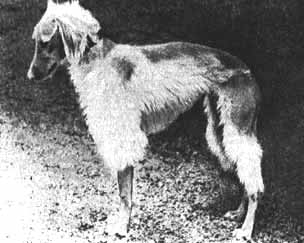
Photo on the left of the Taigan Kara-Kush at the age of 10 years by E. Shishkina
áPhoto on the right of the Aboriginal Afghan of G. Geraseva of 1985 by V. Zhitovchenko
The
Taigan is somewhat “more warmly” dressed than the Bakhmull.
As for the difference
in colour, that is to say: the faults in the contemporary version
of the standard for the
Bakhmull of black and black dappled (which is typical of the
Taigan), which were allowed
in the old version. Is it possible that the disappearance of the
dark colours in the Bakhmull
was consciously or unconsciously aimed at distinguishing it from
the Taigan? With regard
to attempts to separate artificially “new” breeds of dogs, by
issuing new standards, the view
of S. Matveev seems entirely reasonable:
“ ….it should have been understood long ago that the first
priority is the Breed (the material)
and not the Standard (the idea)”.".
The
facts adduced by Sir Terence Clark speak clearly about the smooth
transition of the
Afghan/Bakhmull to the plains type of Tazy/Saluki in Afghanistan.
It is
absolutely natural that a breed distributed over a huge expanse
of the “Old World”
should have taken on local external characteristics, which are
often of an adaptive character,
and with certain peoples and tribes local names for these
Sighthounds should spring up.
However the most widespread names Tazy and Saluki simply indicate
the region of origin
of the breed (see the translator's observations on the article
“The northern frontiers
of Salukidom”).
This is equally confirmed by the fact that the means of hunting
with the Saluk/Tazy appear
practically identical in the various corners of the natural
environment of their distribution:
the mounted hunt, using Sighthounds simultaneously with raptors
and carrying them
on horseback to conserve their strength (remember the Chinese
example of the 10th
century described by Sir Terence Clark), which is fundamentally
different from the means
of hunting with Sighthounds in Europe.
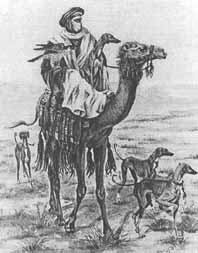
Photos of Tuareg hunting
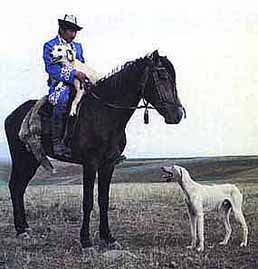
Photo of Kazakhs hunters with Tazys and golden eagles
In
conclusion I should like to dwell on the demands of the breed
standards. Without
doubt the existence of standards is an inalienable part of
contemporary animal husbandry.
However attempts to squeeze into the narrow framework of the
standard a breed that has so
many varieties often leads to confusion and acts only to limit
and to impoverish its genotype.
Remember the abovementioned fact of the standards of the Bakhmull
and Taigan.
The exclusion according to the currently effective standards on
the territory of the former
Soviet Union of the Tazy with red patches and spots on the body,
although such colour
is normal beyond the borders of CIS (Confederation of Independent
States) (see the photo
in “The northern frontiers of Salukidom).
It is
surprising to see that the western standard for the Saluki
considers brindle as “untypical”.
However it is known that brindle Sighthounds are sufficiently
typical for North Africa and
are accepted as typical in the current standard for the Taigan
(“Hunting Hounds” No. 6, 2000).
Modest Bogdanov in the magazine “Nature and Hunting” in
January 1879 notes the brindle colour
as typical for Kazakh Tazys (my own Sighthounds, imported from
Kazakhstan, are brindle).
Sir Terence Clark also saw brindles in parts of the Middle East. .

Photo
of one example of a brindle bitch from near Tehran
by Margret Tamp
Today as
is known the Central Asiatic Sighthounds – Tazy,
Taigan, Bakhmull – are on the verge of disappearing and the
number of pedigree specimens is limited to, perhaps, a few
hundred, in my view, the exclusion entirely of pedigree hounds
according to dubious “faults” such as “untypical colour”
or even the absence of a hook in the tail seems not only
unreasonable but also dangerous for the further existence
of the breed.
*************
* Footnote
The
American biologist and expert on eastern Sighthounds Dr John
Burchard, who lived for a long time
in the Near East and is well acquainted with our breed in its
natural surroundings, suggests that the name
Saluki and Sloughi are derived from the same Arabic word which in
the East is written Saluqi and is used for
Sighthounds originating in the countries of the East.
The
Arabic guttural sound which is designated by the letter “q”.
called “qaf”, has no equivalent in European
languages. The British translate it with the help of the latter
“k”: hence Saluki. The French designate this sound
by “gh” and according to the rules of French orthography we
have “Sloughi”. Arab experts according to
Dr John Burchard regard Western attempts to consider “Saluki”
and “Sloughi” as different breeds as absurd.
© Ukrainian magazine "Naturalist"